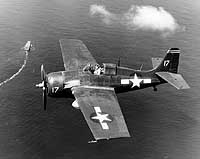
In 1942, automobile manufacturer General Motors converted several of its east coast factories to aircraft production under the name Eastern Aircraft Division. Eastern received contracts to build F4F-4 "Wildcat" fighters and TBF-1 "Avenger" torpedo planes, allowing Grumman to gradually reconcentrate its energies on the new, urgently-needed F6F "Hellcat" fighter. The GM F4F-4s, redesignated FM-1s, had only four .50 caliber machine guns, but were otherwise little changed from the original model. Well over a thousand FM-1 fighters were delivered in 1942-43, including some three hundred for the British Royal Navy.
Meanwhile, Grumman had prototyped a new "Wildcat" under the designation XF4F-8, which was to be produced by Eastern Aircraft as the FM-2. With lightened structure and a more powerful Wright R-1820 radial engine, the FM-2 was notably quicker, faster climbing, longer ranged and more maneuverable than its predecessor. To help control the increased power, the new plane had a distinctive, taller vertical tail. All-in-all, it was a great improvement, and more than four thousand FM-2s were built in 1943-45. Of those, over three hundred went to the British.
The U.S. Navy FM-2s operated exclusively from escort carriers (CVEs), small ships with notoriously lively flight decks. They were used in the Atlantic, teamed with TBM "Avengers" for anti-submarine work, the escort carriers' original purpose. In the Pacific, CVEs did ASW too, but also employed their "Avengers" and "Wildcats" to provide air cover for invasion forces and close air support for ground troops. Those missions produced opportunities for aerial combat against Japanese planes, and two Navy pilots achieved "ace" status in FM-2s. The GM "Wildcat" also played an important role in the 25 October 1944 Battle off Samar, in which a force of the slow CVEs and their escorts out-fought a vastly superior Japanese surface fleet.
FM-2 "Wildcat" characteristics:
This page features, and provides links to, selected views of General Motors FM-2 fighters.
For more images of FM-2 fighters, see:
For pictorial coverage of other types of "Wildcat"
fighters, see:
| If you want higher resolution reproductions than the digital images presented here, see: "How to Obtain Photographic Reproductions." |
Click on the small photograph to prompt a larger view of the same image.
|
Photo #: 80-G-224669 General Motors FM-2 "Wildcat" fighter (Bureau # 15953, the second production FM-2) Undergoing flight testing, circa late 1943. Official U.S. Navy Photograph, now in the collections of the National Archives. Online Image: 91KB; 740 x 615 pixels Reproductions of this image may also be available through the National Archives photographic reproduction system. |
 |
|
Photo #: 80-G-222824 General Motors FM-2 "Wildcat" fighter In flight in the Atlantic area, 10 February 1944. The plane is from USS Card (CVE-11). Official U.S. Navy Photograph, now in the collections of the National Archives. Online Image: 71KB; 740 x 615 pixels Reproductions of this image may also be available through the National Archives photographic reproduction system. |
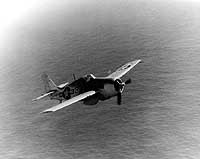 |
|
Photo #: 80-G-269036 General Motors FM-2 "Wildcat" fighter Flies near USS Core (CVE-13), during operations in the North Atlantic, 12 April 1944. Plane has its landing gear and tailhook down, in preparation for landing on board. Official U.S. Navy Photograph, now in the collections of the National Archives. Online Image: 64KB; 740 x 620 pixels Reproductions of this image may also be available through the National Archives photographic reproduction system. |
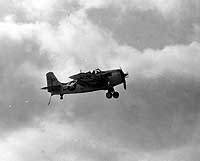 |
|
Photo #: 80-G-287594 General Motors FM-2 "Wildcat" fighter On combat air patrol over USS Santee (CVE-29), during the Leyte Invasion, 20 October 1944. Official U.S. Navy Photograph, now in the collections of the National Archives. Online Image: 90KB; 740 x 615 pixels Reproductions of this image may also be available through the National Archives photographic reproduction system. |
 |
|
Photo #: 80-G-384058 General Motors FM-2 "Wildcat" fighters From USS White Plains (CVE-66), fly an escort mission, probably during air strikes on Japanese facilities on Rota Island, Marianas, 24 June 1944. Note island in the distance. Official U.S. Navy Photograph, now in the collections of the National Archives. Online Image: 85KB; 740 x 615 pixels Reproductions of this image may also be available through the National Archives photographic reproduction system. |
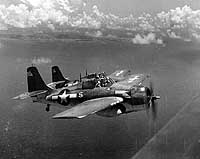 |
|
Photo #: 80-G-287497 Battle off Samar, 25 October 1944 USS Kitkun Bay (CVE-71) prepares to launch FM-2 "Wildcat" fighters during the action. In the center distance, Japanese shells are splashing near USS White Plains (CVE-66). Official U.S. Navy Photograph, now in the collections of the National Archives. Online Image: 80KB; 650 x 675 pixels Reproductions of this image may also be available through the National Archives photographic reproduction system. |
 |
|
Photo #: 80-G-K-1601 (Color) FM-2 "Wildcat" fighter Prepares to take off from USS Charger (CVE-30) during training operations in the Chesapeake Bay area, 8 May 1944. Another FM-2 is passing overhead with its tail hook down, apparently having received a "wave-off" due to the carrier's fouled flight deck. Note the light Atlantic area paint schemes worn by these planes. Official U.S. Navy Photograph, now in the collections of the National Archives. Online Image: 83KB; 590 x 765 pixels Reproductions of this image may also be available through the National Archives photographic reproduction system. |
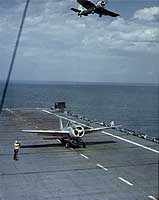 |
|
Photo #: NH 94870 FM-2 "Wildcat" fighter Receives the "launch" signal on USS Makin Island (CVE-93), 1945. Courtesy of PHC John Highfill, USN (Retired). U.S. Naval History and Heritage Command Photograph. Online Image: 61KB; 740 x 530 pixels |
 |
|
Photo #: 80-G-269035 General Motors FM-2 "Wildcat" fighter Is catapulted from USS Core (CVE-13), in the North Atlantic, 12 April 1944. Taken by Photographer's Mate N.H. Seehafer. Official U.S. Navy Photograph, now in the collections of the National Archives. Online Image: 82KB; 740 x 605 pixels Reproductions of this image may also be available through the National Archives photographic reproduction system. |
 |
|
Photo #: NH 94880 USS Makin Island (CVE-93) A FM-2 "Wildcat" fighter makes the ship's last catapult launching, off Honolulu, Hawaii, in October 1945. Note the catapult bridle dropping away below the plane's wheels. Courtesy of PHC John Highfill, USN (Retired). U.S. Naval History and Heritage Command Photograph. Online Image: 83KB; 740 x 605 pixels |
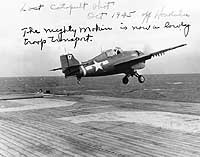 |
For more images of FM-2 fighters, see:
For pictorial coverage of other types of "Wildcat"
fighters, see:
NOTES:
| If you want higher resolution reproductions than the digital images presented here, see: "How to Obtain Photographic Reproductions." |
Page made 21 January 2001
Coding updated 6 May 2009